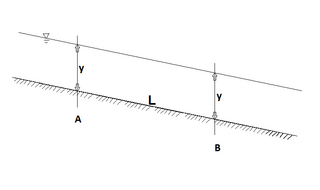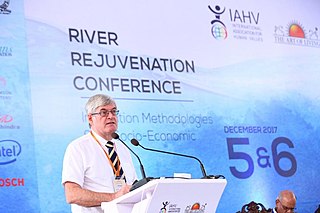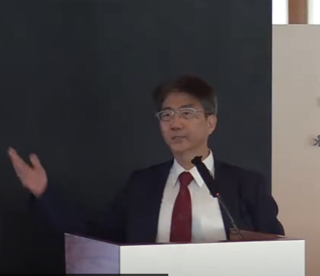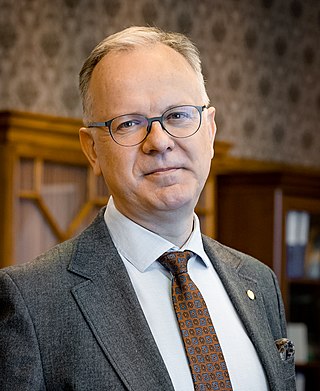Related Research Articles

Hydraulics is a technology and applied science using engineering, chemistry, and other sciences involving the mechanical properties and use of liquids. At a very basic level, hydraulics is the liquid counterpart of pneumatics, which concerns gases. Fluid mechanics provides the theoretical foundation for hydraulics, which focuses on applied engineering using the properties of fluids. In its fluid power applications, hydraulics is used for the generation, control, and transmission of power by the use of pressurized liquids. Hydraulic topics range through some parts of science and most of engineering modules, and cover concepts such as pipe flow, dam design, fluidics and fluid control circuitry. The principles of hydraulics are in use naturally in the human body within the vascular system and erectile tissue.

Hydraulic engineering as a sub-discipline of civil engineering is concerned with the flow and conveyance of fluids, principally water and sewage. One feature of these systems is the extensive use of gravity as the motive force to cause the movement of the fluids. This area of civil engineering is intimately related to the design of bridges, dams, channels, canals, and levees, and to both sanitary and environmental engineering.

A culvert is a structure that channels water past an obstacle or to a subterranean waterway. Typically embedded so as to be surrounded by soil, a culvert may be made from a pipe, reinforced concrete or other material. In the United Kingdom, the word can also be used for a longer artificially buried watercourse.
Hydroinformatics is a branch of informatics which concentrates on the application of information and communications technologies (ICTs) in addressing the increasingly serious problems of the equitable and efficient use of water for many different purposes. Growing out of the earlier discipline of computational hydraulics, the numerical simulation of water flows and related processes remains a mainstay of hydroinformatics, which encourages a focus not only on the technology but on its application in a social context.
Hunter Rouse was a hydraulician known for his research on the mechanics of fluid turbulence.
International Journal of River Basin Management is a quarterly academic journal issued for the first time during the Third World Water Forum in Kyoto, March 2003. It is published in print and electronic format by Taylor & Francis, on behalf of the International Association of Hydraulic Engineering and Research, the International Association of Hydrological Sciences and the International Network of Basin Organizations.
The International Association of Hydrological Sciences (IAHS) is a non-profit, non-governmental scientific organization committed to serving the science of hydrology and the worldwide community of hydrologists. The IAHS was established in 1922, and presently claims a membership in excess of 9,000 with members in over 150 countries.

Hubert Chanson is a professional engineer and academic in hydraulic engineering and environmental fluid mechanics. Since 1990 he has worked at the University of Queensland.

Theodor Christoph Heinrich Rehbock was a German hydraulics engineer, and professor at the University of Karlsruhe.
HR Wallingford was previously the Hydraulics Research Station (HRS). It was created by the UK Department of Scientific and Industrial Research in 1947. The Research Station was based in Wallingford, near Oxford. It was established to deal with “looser boundary” problems such as coastal erosion, flood protection and the silting and scouring of rivers, estuaries and harbours. The Hydraulics Research Station was housed at Howbery Park as a government establishment until 1982, when it was privatised from the Department of the Environment to become Hydraulics Research Station Limited. It is known as HR Wallingford. During its existence, HRS contributed to advance hydraulics research. It also worked on water-related projects in the UK and around the world.

Aldeadávila Dam is a concrete arch-gravity dam on the Duero River in Spain, near the border with Portugal. The nearest town is Aldeadávila de la Ribera in the Province of Salamanca, about 11.3 kilometres (7.0 mi) to the east. The nearest Portuguese town is Fornos in Bragança District, about 8 kilometres (5.0 mi) to the southwest. The Portuguese side of the river around the dam site lies within the Arribes del Duero Natural Park.

Subhasish Dey is a hydraulician and educator. He is known for his research on the hydrodynamics and acclaimed for his contributions in developing theories and solution methodologies of various problems on hydrodynamics, turbulence, boundary layer, sediment transport and open channel flow. He is currently a professor of the department of civil engineering, Indian Institute of Technology Kharagpur, where he served as the head of the department during 2013–15 and held the position of Brahmaputra Chair Professor during 2009–14 and 2015. He also held the adjunct professor position in the Physics and Applied Mathematics Unit at Indian Statistical Institute Kolkata during 2014–19. Besides he has been named a distinguished visiting professor at the Tsinghua University in Beijing, China.

Forrest Merton Holly Jr. was an American civil engineering professor, an hydraulician and the co-inventor of the Holly-Preissmann scheme for simulating transport of contaminants and suspended sediments in rivers. Holly was an expert in computational hydraulics, dispersion in natural waters, alluvial river processes, urban hydraulics, thermal transport in rivers, and irrigation control systems with interest the solution of practical river engineering problems..

Willi H. Hager is a Swiss civil engineer and Professor at the ETH Zurich, Department of Civil, Environmental and Geomatic Engineering, known for his work on hydraulics.
The International Science Council (ISC) is an international non-governmental organization that unites scientific bodies at various levels across the social and natural sciences. The ISC was formed with its inaugural general assembly on 4 July 2018 by the merger of the former International Council for Science and the International Social Science Council (ISSC), making it one of the largest organisations of this type.

Roger Alexander Falconer FREng, ForMemCAE, FLSW, FEurASc, is Emeritus Professor of Water and Environmental Engineering at Cardiff University, Independent Water Engineering and Environmental Management Consultant, Tidal Energy Consultant, and Chair Professor at Hohai University and the Yangtze Institute for Conservation and Development, China.

Joseph Hun-wei Lee is a Chinese civil engineer, currently serving as president of the Macau University of Science and Technology.

Paweł Mariusz Rowiński (born 26 February 1965) is a Polish hydrogeologist, hydrodynamicist, geophysicist, full professor at the Institute of Geophysics, Polish Academy of Sciences, a full member of the Polish Academy of Sciences, vice-president of the Polish Academy of Sciences.
Abdin Mohamed Ali SalihFAAS FTWAS FIWRA is a Sudanese Civil Engineering Professor at the University of Khartoum and a UNESCO expert in Water Resources.
References
- ↑ "CEDEX". Cedex.es. Retrieved 16 August 2018.
- ↑ "Archived copy". Archived from the original on 2015-09-09. Retrieved 2015-09-02.
{{cite web}}: CS1 maint: archived copy as title (link) - ↑ "Journal Hydraulic Research - Making sure that science becomes the most important world business". Journal Hydraulic Research. Retrieved 16 August 2018.
- ↑ "J R B M". Archived from the original on 2008-07-24. Retrieved 2008-07-05.
- ↑ "International Association for Hydro-Environment Engineering and Research". Archived from the original on 2013-12-07. Retrieved 2013-12-03.
- ↑ "Journal of Hydro-environment Research - 1570-6443". Elsevier.com. Retrieved 16 August 2018.
- ↑ "RIBAGUA - Revista Iberoamericana del Agua". Elsevier.es. Retrieved 16 August 2018.